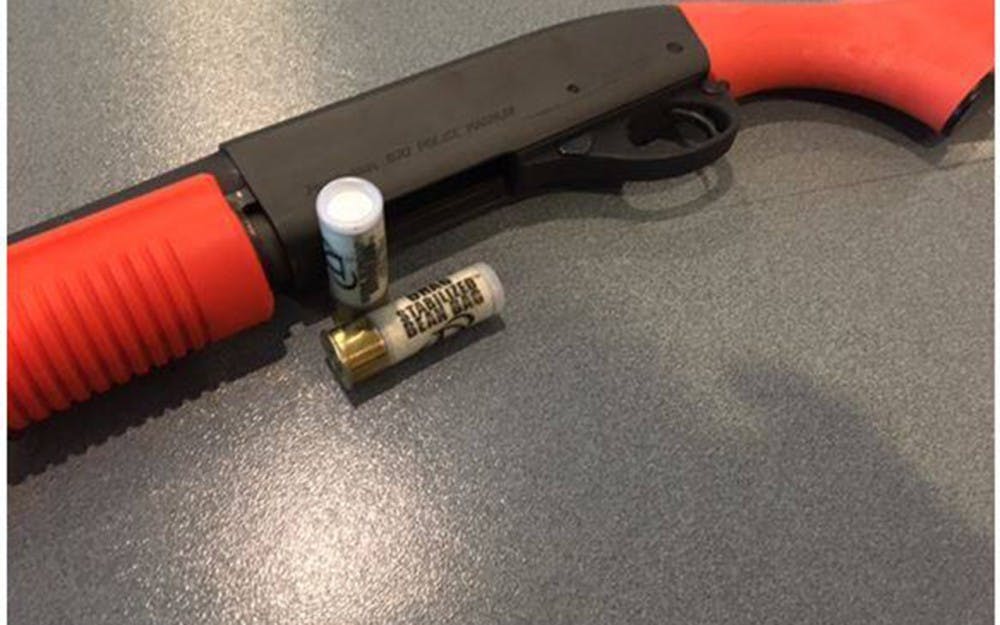The woman had thrown the knife down, but no matter how many times the officers told her, she wouldn’t stop reaching behind her back.
“Let’s see your hands,” an officer said, according to a police report relayed Wednesday by Bloomington Police Department Lt. John Kovach.
The woman, 26-year-old Consuela Hallal, called police Tuesday morning to her South Rockport Road apartment. She said she’d stabbed herself. However, officers found her unharmed on her bed with the knife beside her. She’d already touched the long-bladed kitchen knife when they’d asked her not to, and now she wouldn’t stop grasping at some unseen object behind her.
The officers said they had to subdue her somehow, but this didn’t call for lethal force, and if she had another weapon — they later found a hammer on a plastic nightstand she’d obscured — a close-range tactic like using pepper spray or a baton could put an officer in danger.
They had access to a new option — less-lethal launchers — shotguns modified to fire bean-bag rounds rather than bullets — instituted in late December by BPD.
The round hit Hallal in the leg, and officers cuffed her and took her to IU Health Bloomington Hospital for a mental health evaluation. When the hospital released her Wednesday, officers arrested her on felony charges of battery, intimidation and criminal recklessness.
The new launchers provide at least a partial solution to a problem the department has faced, BPD Capt. Steve Kellams said. Batons and pepper spray aren’t as lethal as bullets, but they do require officers to get within a couple of feet of potentially dangerous subjects.
“These are going to be used at the same time we’d use a baton strike on someone, but you don’t have to be at close range,” he said.
In addition to officer safety, the distance allows for more time to make decisions in particularly volatile situations, Kellams said. If a raging suspect is high on a drug like PCP, they may not be deterred by the pain inflicted by a less-lethal weapon. That extra space means officers have a little extra time to decide what to do next.
Longer-range less-lethal weapons aren’t entirely new to the BPD. The department already had a pair of 40-millimeter multilaunchers, pieces of weaponry equipped to fire gas canisters and sponge grenades, foam-and-plastic rounds often used for riot control. However, Kellams said only the department’s critical response team members were trained to use the multilaunchers, which meant if police wanted to use one they’d have to hope one of those officers was around or wait for one to become available.
In May 2015 the Task Force on 21st Century Policing established by President Obama released its final report on modern law enforcement practices. In the wake of high-profile shootings of unarmed black men and boys by officers, the report recommended a host of new or updated procedures and practices, including less-lethal weaponry.
“Policies and procedures must change, but so should the weaponry,” it read. It noted how studies have shown the weaponry to be effective in reducing injuries to both officers and civilians.
It was one of the recommendations BPD took note of when reviewing the report.
“We spent all last year going pillar-by-pillar and looking at what we did well and what we need to improve on,” Kellams said.
As it turns out, the department’s solution was in storage. After an infamous 1997 shootout in North Hollywood exposed the ineffectiveness of standard-issue shotguns, departments across the country shifted to using patrol rifles, Kellams said. That left about 20 shotguns in BPD’s possession with nobody to use them.
So BPD modified them to fire bean-bags, and now four or five of them are assigned to officers on each shift, which is a sharp increase in the number of less-lethal weapons available in the department at a given time. Kellams said this step forward isn’t radical in the law enforcement community but is an improvement.
“It’s old technology, but it’s new to us,” he said.
He’s careful to not call these weapons non-lethal. A bean-bag round to the eye could kill someone just as a poorly placed baton could, he said.
It’s not a be-all-end-all solution either, Kellams said. BPD wants to continue to research other less-lethal weaponry, including electrical less-lethal weaponry like Tasers. It’s progress that deserves more thought.
“This is just another tool in the toolbox,” he said.




